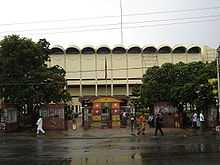Bangladesh National Museum
Coordinates: 23°44.25′N 90°23.67′E / 23.73750°N 90.39450°E

| Part of a series on the |
| Culture of Bangladesh |
|---|
 |
|
|
|
Traditions
|
|
|
| Religion |
|
|
|
Literature History
Genres
Institutions Awards Writers
|
|
Music and performing arts |
|
Media
|
|
|
Monuments |
|
The Bangladesh National Museum (Bengali: বাংলাদেশ জাতীয় যাদুঘর), originally established on 20 March 1913, albeit under another name, and formally inaugurated on 7 August 1913, was accorded the status of the national museum of Bangladesh on 17 November 1983. It is located Shahbag, Dhaka. The museum is well organized and displays have been housed in several departments like department of ethnography and decorative art, department of history and classical art, department of natural history, and department of contemporary and world civilization. The museum also has a conservation laboratory.
Ground floor
The ground floor consists of some old guns at the entrance and the hall where the people book their tickets or assemble to hear the history of the museum. The hall leads to a grand staircase. Beside the hall, there is a smaller room which also acts like the hall (it is also used by the guides to tell the visitors about the history) and a simple staircase.
1st floor
The 1st floor is divided into 22 rooms.
1st room
The first room consists of a large map showing the map of Bangladesh and the 64 districts.
2nd room
The 2nd room consists of an under going work of a large statue of the Royal Bengal Tiger.
3rd-10th room
These rooms consists of natural beauties found in Bangladesh. In one of the room there is showcase of a tongue of a whale.
10th-22nd room
The other rooms contain some historic relics of Bengal up to 1900. There is a room which shows the different boats used by the rural people.
2nd Floor
The 2nd floor consists of photos of famous people and showcases the Bangladesh Liberation War and the Language Movement of 1952. There are posters used in the war, a torture machine and much more. There are also two libraries
3rd Floor
The 3rd Floor consists of Pictures of International politicians, artists, scientists, famous pictures and three international galleries- Korean, Iranian and Swiss
External links
See also
| ||||||||